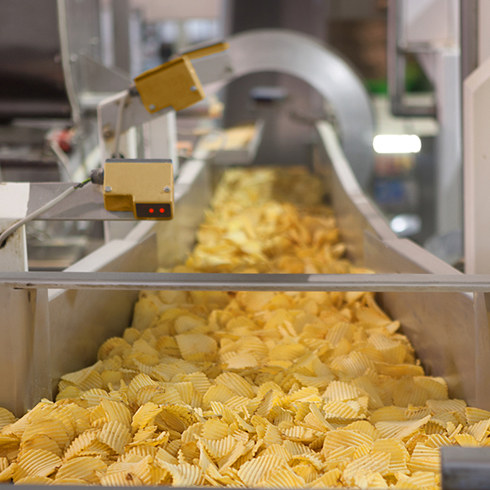The bottom line in food and beverage manufacturing is not only driven by the volume of output but also by the efficiency with which inputs are transformed into end products.
Minimizing waste is no longer just an environmental buzzword; it’s a core business strategy that significantly impacts profitability and industry reputation. Let’s explore a few high-impact strategies you can adopt to reduce waste and increase output.
Streamlining Procurement Processes
The procurement of raw materials represents a key aspect of food and beverage production, yet it’s also a common source of excess. To optimize procurement, businesses must adopt just-in-time (JIT) inventory systems that align orders with production schedules, effectively reducing spoilage and overstocking.
Example: In an ice cream manufacturing facility, adopting just-in-time (JIT) inventory systems involves ordering ingredients like milk, cream, and flavorings precisely when needed for production. By closely coordinating ingredient deliveries with production schedules, the facility can reduce excess inventory and minimize waste. This approach ensures that ingredients are used efficiently, maintains freshness, and reduces the risk of product spoilage. Ultimately, implementing JIT inventory systems in ice cream production enhances efficiency, lowers storage costs, and promotes sustainability.
Implementing Lean Manufacturing Techniques
Lean manufacturing is a practice that aims to eliminate waste through continuous improvement and synchronizing production steps. By streamlining workflows and reducing idle time between processes, businesses can minimize overproduction—one of the primary wastes in the lean framework.
Example: In a packaged snack manufacturing facility, implementing Lean manufacturing techniques involves controlling variation in product weight to minimize waste and ensure consistency in quality. For instance, by calibrating filling machines to dispense precise amounts of ingredients into each package and implementing quality control checks at regular intervals, the facility can minimize overfilling or underfilling of product. Additionally, by optimizing production line layouts and minimizing changeover times between different product runs, the facility can reduce idle time and increase overall throughput. These improvements not only enhance product quality but also reduce waste and improve efficiency in the manufacturing process.
Enhancing Food Processing Methods
Efficiency in food processing is gained through refining techniques that extract maximum value while minimizing by-products. Optimizing cooking temperatures, reducing processing times, and re-utilizing food scraps can contribute significantly to waste reduction.
Example: In a cereal manufacturing plant, enhancing food processing methods involves optimizing techniques to minimize waste and enhance product quality. For instance, by fine-tuning the mixing and baking processes to ensure an even distribution of ingredients and consistent product texture, the plant can reduce the likelihood of batch rejection and minimize material waste. Additionally, implementing measures to repurpose cereal crumbs or imperfect pieces for use in granola bars or as ingredients in other products helps to maximize resource utilization and minimize waste. These enhancements not only improve overall efficiency in cereal production but also contribute to sustainability efforts and cost reduction.
Advancing Packaging and Storage Solutions
Innovative packaging that extends product shelf life and storage solutions that better preserve perishable goods are critical in waste management. Companies can leverage smart packaging sensors that alert distributors to nearing spoilage, allowing for proactive stock rotation.
Example: In a french fry production facility, innovative packaging and storage solutions are essential for extending shelf life and minimizing waste. Vacuum-sealed packaging preserves freshness by removing air, while temperature-controlled storage maintains optimal conditions. Smart packaging sensors alert distributors to potential spoilage, enabling proactive measures to prevent waste.
Cultivating a Culture of Operational Excellence
Tackling waste reduction demands a shift in workplace culture, where every employee from top management to the production floor is engaged in identifying inefficiencies. Regular training, incentives for waste-saving ideas, and clear communication of waste reduction goals are all elements that can foster this cultural transformation.
Example: At a seafood processing facility, operational excellence involves engaging all team members in waste reduction initiatives. Workers might optimize filleting techniques to minimize waste, while packaging personnel implement strategies to reduce excess packaging materials. Incentives and regular communication channels ensure collective involvement, fostering a more sustainable operation.
Transforming Waste Reduction into Profit
Waste reduction is not just an environmental consideration but a core business strategy. Refining procurement processes, embracing lean manufacturing, enhancing processing methods, introducing advanced packaging, and establishing a culture of excellence, can help businesses improve their output while springboarding towards a sustainable future. Each strategy comes together to create an integrated approach to waste management—leading not only to sizable environmental benefits but also to tangible enhancements in operational efficiency and profitability. It’s through these focused efforts that the industry can meet productivity goals without leaving a trail of wastefulness.
Learn More About TBM’s Food & Beverage Industry Solutions






